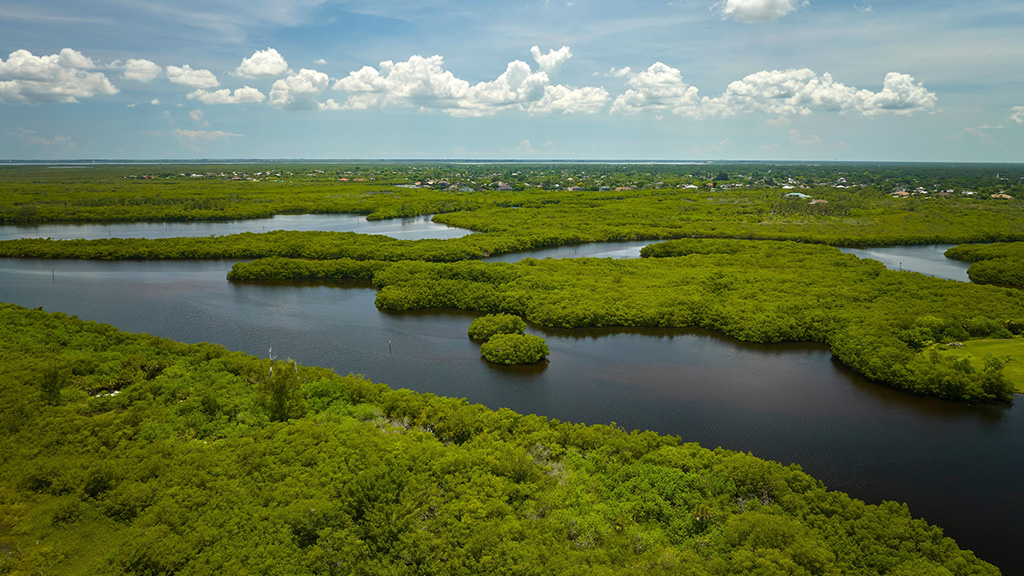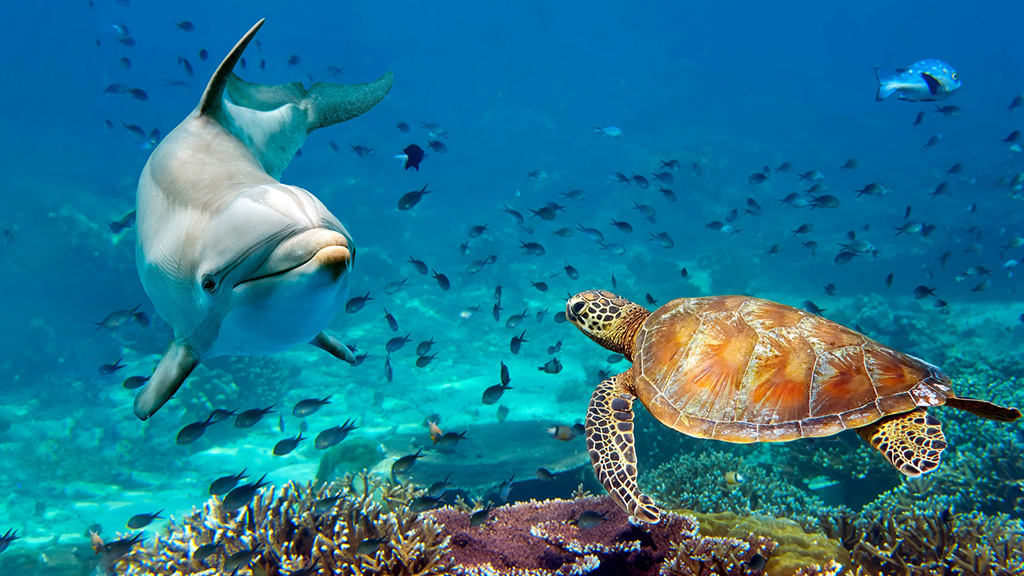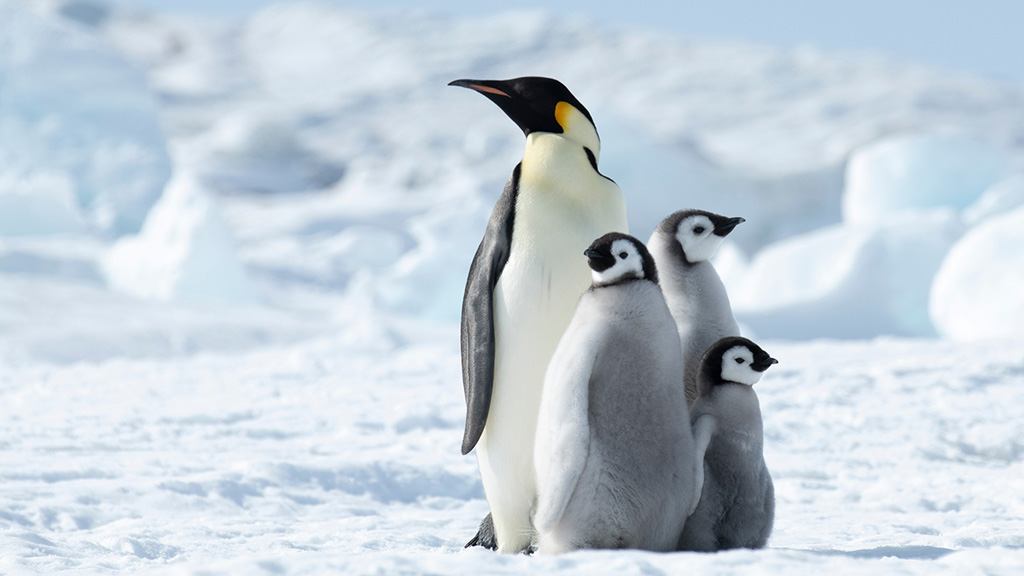Habitats
Hábitats

Florida wetlands
Humedales de Florida
English | LEVEL A

Florida wetlands
Humedales de Florida
Every living thing needs a special place to live. This place is called a habitat. Habitats give plants and animals the food, water, air, and shelter they need to stay alive. Different animals and plants live in different places because they need special things to survive. Let's explore some habitats!
Forests are full of trees, plants, and animals. Animals like deer, bears, and birds live in forests. The trees give them food, shade, and a place to hide. Forests can be warm and rainy, like tropical rainforests, or cold and snowy, like pine forests.
Deserts are very dry and get little rain, but some plants and animals still live there. Cacti store water in their thick stems, and animals like lizards, snakes, and camels are good at surviving in the heat. Some deserts can even be cold, like the ones in Antarctica!
The ocean is a big, salty habitat. Many animals, like fish, dolphins, and whales, live there. Seaweed and coral grow in the ocean and give animals food and shelter. Some animals, like sea turtles, spend time in the ocean and on land.

A dolphin and sea turtle swim in a coral reef
Un delfín y tortuga marina nadan en un arrecife de coral
Freshwater habitats, like rivers, lakes, and ponds, have water that is not. Fish, frogs, and turtles live here. Plants like water lilies and reeds grow near the water, helping keep it clean and safe for animals.
Grasslands are wide, open spaces with lots of grass and a few trees. Big animals like lions, elephants, and bison live here. These animals need a lot of space to eat and roam.
Wetlands are places where land and water meet. They are full of plants like cattails and reeds. Frogs, turtles, and many birds live in wetlands because there is plenty of food and shelter. Wetlands also help keep the water clean and stop flooding.
Some habitats are very cold, like the Arctic. Polar bears, penguins, and seals live in icy places. They have thick fur or fat to stay warm. Mountain goats and snow leopards live on rocky mountains. Plants like mosses grow in these cold habitats.

An emperor penguin and its chicks
Un pingüino emperador y sus polluelos
Habitats are very important. Each plant and animal helps its habitat stay healthy. Bees pollinate flowers, and trees give birds a place to build nests. When habitats are healthy, all the living things there can thrive.
What’s your favorite habitat? Think about why it’s special and why animals and plants live there!
Todo ser vivo necesita un lugar especial donde vivir. Este lugar se llama hábitat. Los hábitats proporcionan a las plantas y animales el alimento, el agua, el aire y el refugio que necesitan para sobrevivir. Diferentes animales y plantas viven en lugares diferentes porque necesitan cosas especiales para sobrevivir. ¡Exploremos algunos hábitats!
Los bosques están llenos de árboles, plantas y animales. Animales como ciervos, osos y aves viven en ellos. Los árboles les brindan alimento, sombra y un lugar donde esconderse. Los bosques pueden ser cálidos y lluviosos, como las selvas tropicales, o fríos y nevados, como los pinares.
Los desiertos son muy secos y reciben poca lluvia, pero algunas plantas y animales aún viven allí. Los cactus almacenan agua en sus gruesos tallos, y animales como lagartos, serpientes y camellos sobreviven bien al calor. ¡Algunos desiertos pueden incluso ser fríos, como los de la Antártida!
El océano es un hábitat extenso y salado. Allí viven muchos animales, como peces, delfines y ballenas. Las algas marinas y los corales crecen en el océano y les proporcionan alimento y refugio. Algunos animales, como las tortugas marinas, pasan tiempo tanto en el océano como en la tierra.

A dolphin and sea turtle swim in a coral reef
Un delfín y tortuga marina nadan en un arrecife de coral
Los hábitats de agua dulce, como ríos, lagos y estanques, tienen agua no estancada. Aquí viven peces, ranas y tortugas. Plantas como nenúfares y juncos crecen cerca del agua, lo que ayuda a mantenerla limpia y segura para los animales.
Los pastizales son espacios amplios y abiertos con abundante hierba y algunos árboles. Aquí viven animales grandes como leones, elefantes y bisontes. Estos animales necesitan mucho espacio para comer y desplazarse.
Los humedales son lugares donde la tierra y el agua se encuentran. Están llenos de plantas como espadañas y juncos. Ranas, tortugas y muchas aves viven en humedales porque hay abundante alimento y refugio. Los humedales también ayudan a mantener el agua limpia y a prevenir inundaciones.
Algunos hábitats son muy fríos, como el Ártico. Los osos polares, los pingüinos y las focas viven en lugares helados. Tienen un pelaje grueso o grasa para mantenerse calientes. Las cabras montesas y los leopardos de las nieves viven en montañas rocosas. Plantas como los musgos crecen en estos hábitats fríos.

An emperor penguin and its chicks
Un pingüino emperador y sus polluelos
Los hábitats son muy importantes. Cada planta y animal contribuye a que su hábitat se mantenga saludable. Las abejas polinizan las flores y los árboles ofrecen a las aves un lugar para construir nidos. Cuando los hábitats son saludables, todos los seres vivos pueden prosperar.
¿Cuál es tu hábitat favorito? ¡Piensa en por qué es especial y por qué los animales y las plantas viven allí!
Every living thing needs a place to live that meets its needs. For plants and animals, this place is called a habitat. Habitats are where plants and animals find food, water, air, and shelter. Plants and animals live in unique habitats because they need different things to survive.
Let’s explore some habitats!
Forests are home to many plants and animals. They have lots of trees, which provide shade and food. In forests, you might find animals like deer, bears, and birds. Plants like ferns, mosses, and wildflowers grow on the forest floor. Some forests, like rainforests, are warm and wet, while others, like pine forests, can be cold and snowy.
Deserts are dry habitats. They get very little rain. You might think it’s hard for anything to live in a desert, but many plants and animals call it home. Cacti are plants that store water in their thick stems. Animals like lizards, snakes, and camels can survive in the hot, sandy conditions. Some deserts can even be cold, like the ones in Antarctica!
The ocean is a salty habitat that covers most of Earth’s surface. Fish, dolphins, and whales are just some of the creatures that call the ocean home. Plants like seaweed and coral grow in the ocean, too. Some animals, like sea turtles and seals, swim in the ocean but come to land to rest or lay eggs.

A dolphin and sea turtle swim in a coral reef
Un delfín y tortuga marina nadan en un arrecife de coral
Freshwater habitats include rivers, lakes, and ponds. These places have water that is not salty. Fish, frogs, and turtles are animals that live in freshwater habitats. Plants like water lilies and reeds grow in the water or along the edges. These plants help keep the water clean and provide food and shelter for the animals.
Grasslands are large, open areas covered with different grasses and shrubs. You might find big animals like bison, lions, and elephants living here. Grasslands often have few trees because they don’t get a lot of rain. This habitat is great for animals that need lots of space to run and graze.
Wetlands are habitats where land and water meet. They are usually marshy and full of plants like cattails and reeds. Frogs, turtles, and birds love wetlands because they provide food and shelter. Wetlands are also important because they help clean water and prevent flooding.
Some plants and animals live in cold habitats like the Arctic or on high mountains. Polar bears, penguins, and seals live in icy places, while mountain goats and snow leopards survive on rocky slopes. These animals have thick fur or blubber to stay warm. Plants like mosses and lichens grow in the Arctic because they can survive the cold weather.

An emperor penguin and its chicks
Un pingüino emperador y sus polluelos
Every habitat is important. Each plant and animal has a role to play in its habitat, and together they form a community. For example, bees help flowers by spreading pollen, and trees provide homes for birds. When habitats are healthy, all living things in them can thrive. What’s your favorite habitat? Think about what makes it special and why plants and animals love it!
Todo ser vivo necesita un lugar donde vivir que satisfaga sus necesidades. Para las plantas y los animales, este lugar se llama hábitat. Los hábitats son donde las plantas y los animales encuentran alimento, agua, aire y refugio. Las plantas y los animales viven en hábitats únicos porque necesitan cosas diferentes para sobrevivir.
¡Exploremos algunos hábitats!
Los bosques albergan muchas plantas y animales. Tienen muchos árboles que proporcionan sombra y alimento. En los bosques, se pueden encontrar animales como ciervos, osos y aves. Plantas como helechos, musgos y flores silvestres crecen en el suelo del bosque. Algunos bosques, como las selvas tropicales, son cálidos y húmedos, mientras que otros, como los pinares, pueden ser fríos y nevados.
Los desiertos son hábitats secos. Reciben muy poca lluvia. Podrías pensar que es difícil vivir en un desierto, pero muchas plantas y animales lo consideran su hogar. Los cactus son plantas que almacenan agua en sus gruesos tallos. Animales como lagartos, serpientes y camellos pueden sobrevivir en condiciones cálidas y arenosas. ¡Algunos desiertos pueden incluso ser fríos, como los de la Antártida!
El océano es un hábitat salado que cubre la mayor parte de la superficie terrestre. Peces, delfines y ballenas son solo algunas de las criaturas que habitan en el océano. Plantas como las algas y los corales también crecen en el océano. Algunos animales, como las tortugas marinas y las focas, nadan en el océano, pero vienen a tierra para descansar o poner huevos.

A dolphin and sea turtle swim in a coral reef
Un delfín y tortuga marina nadan en un arrecife de coral
Los hábitats de agua dulce incluyen ríos, lagos y estanques. Estos lugares tienen agua no salada. Los peces, las ranas y las tortugas son animales que viven en hábitats de agua dulce. Plantas como los nenúfares y los juncos crecen en el agua o en sus orillas. Estas plantas ayudan a mantener el agua limpia y proporcionan alimento y refugio a los animales.
Los pastizales son áreas extensas y abiertas cubiertas de diferentes hierbas y arbustos. Aquí se pueden encontrar animales grandes como bisontes, leones y elefantes. Los pastizales suelen tener pocos árboles debido a la escasez de lluvia. Este hábitat es ideal para animales que necesitan mucho espacio para correr y pastar.
Los humedales son hábitats donde la tierra y el agua se encuentran. Suelen ser pantanosos y estar repletos de plantas como espadañas y juncos. Las ranas, tortugas y aves adoran los humedales porque les proporcionan alimento y refugio. Los humedales también son importantes porque ayudan a purificar el agua y a prevenir inundaciones.
Algunas plantas y animales viven en hábitats fríos como el Ártico o en las altas montañas. Los osos polares, los pingüinos y las focas viven en lugares helados, mientras que las cabras montesas y los leopardos de las nieves sobreviven en laderas rocosas. Estos animales tienen un pelaje grueso o grasa para mantenerse calientes. Plantas como los musgos y los líquenes crecen en el Ártico porque pueden sobrevivir al frío.

An emperor penguin and its chicks
Un pingüino emperador y sus polluelos
Todo hábitat es importante. Cada planta y animal cumple una función en su hábitat, y juntos forman una comunidad. Por ejemplo, las abejas ayudan a las flores distribuyendo el polen, y los árboles sirven de hogar a las aves. Cuando los hábitats son saludables, todos los seres vivos que los habitan pueden prosperar. ¿Cuál es tu hábitat favorito? Piensa en qué lo hace especial y por qué las plantas y los animales lo adoran.